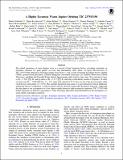A Highly Eccentric Warm Jupiter Orbiting TIC 237913194
Author(s)
Unknown author
DownloadPublished version (8.404Mb)
Publisher Policy
Publisher Policy
Article is made available in accordance with the publisher's policy and may be subject to US copyright law. Please refer to the publisher's site for terms of use.
Terms of use
Metadata
Show full item recordAbstract
© 2020. The American Astronomical Society. The orbital parameters of warm Jupiters serve as a record of their formation history, providing constraints on formation scenarios for giant planets on close and intermediate orbits. Here, we report the discovery of TIC 237913194b, detected in full-frame images from Sectors 1 and 2 of the Transiting Exoplanet Survey Satellite (TESS), ground-based photometry (Chilean-Hungarian Automated Telescope, Las Cumbres Observatory Global Telescope), and Fiber-fed Extended Range Optical Spectrograph radial velocity time series. We constrain its mass to MP = - 1.942+0.091 0.091 MJ and its radius to RP = - 1.117+0.047 0.054 RJ , implying a bulk density similar to Neptune's. It orbits a G-type star (M*= - 1.026+0.055 0.057 M⊙, V = 12.1 mag) with a period of 15.17 days on one of the most eccentric orbits of all known warm giants (e ≈ 0.58). This extreme dynamical state points to a past interaction with an additional, undetected massive companion. A tidal evolution analysis showed a large tidal dissipation timescale, suggesting that the planet is not a progenitor for a hot Jupiter caught during its high-eccentricity migration. TIC 237913194b further represents an attractive opportunity to study the energy deposition and redistribution in the atmosphere of a warm Jupiter with high eccentricity.
Date issued
2020-11Department
Massachusetts Institute of Technology. Department of Physics; MIT Kavli Institute for Astrophysics and Space Research; Massachusetts Institute of Technology. Department of Earth, Atmospheric, and Planetary Sciences; Massachusetts Institute of Technology. Department of Aeronautics and AstronauticsJournal
Astronomical Journal
Publisher
American Astronomical Society
ISSN
1538-3881